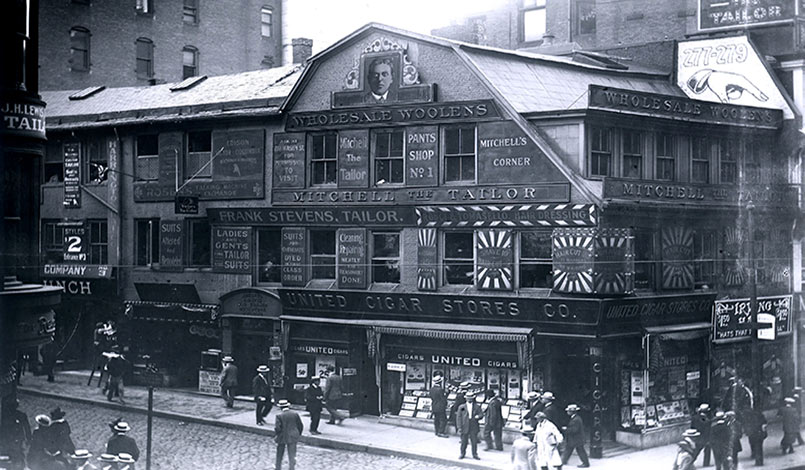
August 22, 2022 What’s the Old Corner Bookstore’s Carbon Footprint? My summer of trying to find out
HBI’s summer intern Chris Impellizeri’s major summer project has been helping HBI understand energy usage of the Old Corner Bookstore complex in order to inform ways we might reduce the property’s carbon footprint and improve its energy performance over time. Simple as it may sound, Chris has discovered that old buildings have a lot of, well, history!
One of the most important aspects of historic preservation today is improving the environmental sustainability of historic buildings as they are restored or rehabilitated. The preservation of certain materials and structural components of historic buildings can sometimes be at odds with the demands of energy, water, and emission sustainability goals. But there are many innovative ways in which both the historic fabric of a community and the environment can be preserved and protected.
HBI is hard at work finding new and innovative ways to make historic landmarks more sustainable for generations to come. As the organization plans new restoration measures for the 1718 Old Corner Bookstore, including new systems, new roofs and restoration of windows and doors, it is looking to understand the current building’s carbon footprint so that it can plan ways to make downtown Boston’s oldest commercial building as efficient as possible.
Part of my summer project for HBI is populating Energy Star’s Portfolio Manager, a suite of online tools that allow property owners and tenants alike to track their water, electric, gas, and waste service usage, with that information for all the Old Corner Bookstore’s tenants. While the process of gathering and interpreting that data is generally seamless for most buildings, I’ve discovered that the Old Corner Bookstore is not like most buildings.
The trouble is, over the course of 304 or so years, the Old Corner Bookstore and its adjacent properties have been carved up, rearranged and leased for different uses countless times. So it’s only natural that over the years documentation of “what switch turns on what?” and “which flushed toilet empties into which sewage pipe?” becomes lost in the annals of history. So, short of cutting the power and seeing which lightbulbs don’t turn on anymore, it can be quite a difficult task to plot out physical connections and meter locations of utilities that will help clarify a historic structure’s utility usage and emissions.
Perhaps the best way to describe my efforts to enter data into Portfolio Manager for the Old Corner Bookstore complex – which is actually made up of four smaller buildings — is being incredibly reminiscent of untangling holiday string lights. The more I pull at one end, the more knots I discover. And even when the knots are untangled and the lights don’t even work when plugged in because of a singular bulb somewhere down the line. So, to determine meter connections and their associated building occupant, the location of connections and where they go in a 300-year-old set of buildings has been nothing short of a challenge.
But just as a rush of relief and satisfaction flows from a properly untangled string of lights, so too will be the reward of a holistic picture of the Old Corner Bookstore’s carbon footprint. Once the property’s Portfolio Manager data is in, HBI will have an important perspective on a structure’s current environmental impact and ways we can plan a more efficient future.
For me, the project is more than data entry. It’s also been a great way to experience and understand the unique construction and materials of a historic building and its uses over time. Digging through dusty documents and exploring a 300-year-old basement can lead to some exciting discoveries after all.
HBI hopes to share its findings from this very in-progress project sometime soon. It will inform the organization’s plans for making the historic complex into a high performing, energy efficient building that will keep our city’s history alive in a brighter, more sustainable future.
And, in the near term, I’m more than prepared to help out with decorations come December!



